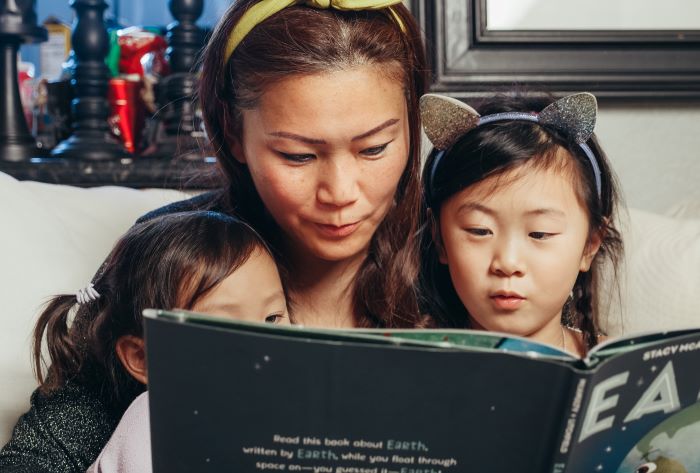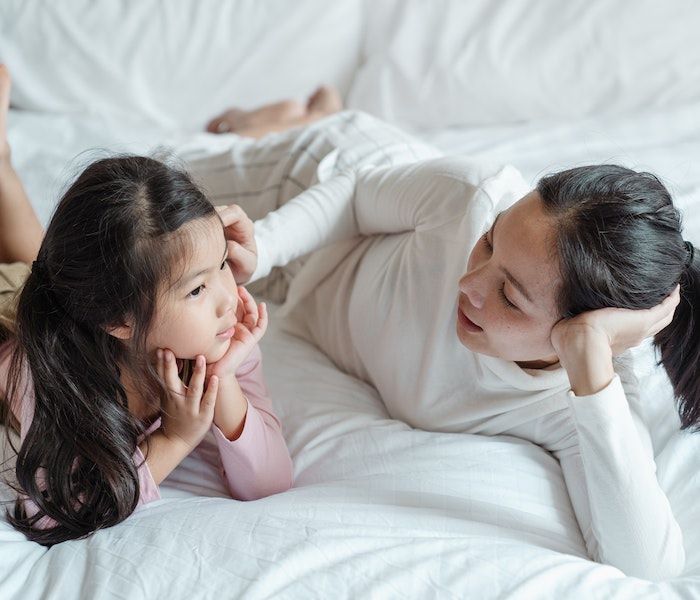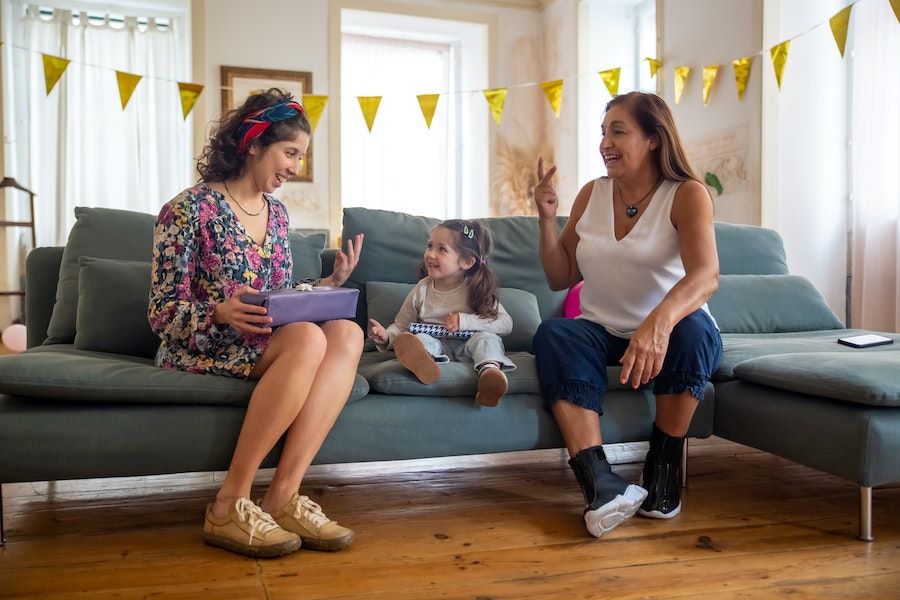Are you a bilingual or multilingual parent looking for the best way to teach your children both languages? Teaching kids another language (or two or three) can be tough. OPOL (One Person, One Language) is a popular technique that can help parents raise their kids to be proficient in multiple languages.
Why go through the trouble? You may want to expose your child to a minority language, or bilingual parents may want to pass the bilingualism to the next generation! The parents don’t even have to speak the same minority language. We’ll discuss creating an environment that promotes success during your child’s bilingual journey, key considerations, and tips for getting started with one parent one language !
What is the OPOL method
OPOL stands for “One Person, One Language.” It’s a multilingual parenting strategy for minority language exposure where one parent speaks a single language to the child. This bilingual parenting method often involves one parent speaking a minority language (primarily) while the other parent speaks the community language). Other adults in the home can also use another language (so if you have grandparents in the household, this could be more than 2 languages!)
This language approach aims to raise multilingual children in which each parent speaks to the child in a different language. This method is based on the idea that a child who is exposed to multiple languages from a young age can develop the ability to speak and understand both languages fluently.
How does One Person One Language Work
The goal of the OPOL method is to help children maintain proficiency in more than one language while also strengthening their connection to their native culture
How to Raise Multilingual or Bilingual Children with OPOL
In an one parent one language household, one parent will speak to the child in their native language, while the other parent will speak to the child in their native language. One of these languages will be the minority language. For example, the native English speaker parent might speak to the child in English, while the Chinese-speaking parent will speak to the child in Chinese. This allows the child to be exposed to and learn both languages simultaneously.
Be Consistent
Bilingual parenting isn’t easy, but as long as a parent provides consistent exposure to the target language, kids can still become bilingual over time. Kids must hear and understand the new language regularly and consistently; this is where OPOL really shines. With a dedicated parent providing sustained daily exposure to especially the minority language, they don’t have to worry so much about finding opportunities for practice outside of the home.
Find other speakers
If your child is attending a bilingual school or a school immersed in a minority language, Research has shown that children who grow up in bilingual households or attend bilingual schools are more likely to develop strong language skills in both languages than children who do not have such exposure.
Use All Resources
Raising bilingual kids has gotten much easier in the digital age even if the target language is a non native language for a parent. Online resources and tutors can also help monolingual children pick up another language.
If a parent has some proficiency in another language, the parent often needs to make a special effort to use it regularly with the child. This can be accomplished by seeking out resources that teach and reinforce the minority language, such as books, websites, radio programs and television shows in the target language. Additionally, hiring tutors or enrolling children in classes can provide extra support for their language development. You don’t have to do this alone!

Don’t be scared of adding languages
While raising bilingual kids might seem achievable to some, adding on more languages might seem daunting. With OPOL of course you would need more adults in this equation. Thanks to the internet, they don’t even have to live with you — for example a grandparent could speak his/her native tongue to your child.
Don’t forget a common language for the adults
In a OPOL (One Person, One Language) household, parents speak with each other in the language they are most comfortable speaking with.
That might mean the community or majority language, but for immigrants (like many bilingual families are) it could be the minority language, which further reinforces the language.
Benefits of the OPOL method
Access to a minority language and culture
What’s most important when raising bilingual kids is that the consistency involved in their everyday lives such as celebrating holidays and regularly attending cultural events are done so in both languages. As a parent, not only are you sharing your native culture and language, but you are sharing a part of you.
Creating this type of home environment can open up a world of possibilities for your children and help create a strong multilingual foundation to build upon throughout their lives.
Giving children an edge
Multilinguilism provides kids with an edge in many areas–from academics to being global citizens. Using the OPOL (one parent, one language) method is an effective way of giving your children the gift of speaking and reading multiple languages. Even if only one parent knows the minority language, it is often enough for their child to have exposure from a dedicated parent.
Evidence suggests that the OPOL method can be effective for helping kids learn a second language. For example, a study published in the journal Bilingualism: Language and Cognition in 2009 found that children who were raised in a bilingual family using OPOL had better language skills in both languages than children who were raised monolingually.
Downsides of using OPOL
OPOL can have its downsides, depending on the perspective. However, some also see these consequences as positives, and indeed, they can be reframed as such.
Family Conversation
It would be a bit more difficult to have everyone using different languages in one conversation, though it’s certainly possible and and sometimes can add to the conversation.
If everyone in the family has reasonable fluency in the same languages, the whole family can speak several together. Sometimes certain phrases have specific meanings in different languages, and using it would be helpful. This use of more than one language in a sentence is called code switching.
More likely than not though, family conversations will occur in a main language, either the immersive home language that is can be parents’ native languages, or the community language.
The realities of OPOL are that it really doesn’t have to apply to family conversations. Nor does it have to be a strategy in use 100% of the time for your child to learn the minority language.
Family Dynamic
Using different languages between the kids and sometimes the parents can change the family dynamic. When I was living in Korea and my daughter was first learning how to speak, she would speak to me in Chinese and speak to her Dad in Korean. Because she started going to a school there, her Korean was essentially native and she conversed fluently.
I’ll admit it wasn’t always easy having my first-born spend half the time speaking a language I didnt understand. I needed my husband to translate sometimes, which wasn’t ideal. So in practicing OPOL, you might want to consider the patience and willingness of the other parent to translate.
Effort
OPOL can be difficult to implement as it requires adults who are both willing and able to communicate with their children in multiple languages. Second or third generation immigrant parents may not be fluent in the target minority language. It could require more persistence because using that language isn’t as natural. But children do not have to have bilingual parents to become bilingual!
If parents have limited or no fluency, introducing a new language can be difficult and time consuming. However it’s always possible to outsource teaching to a bilingual school or tutor.
However, the effort put into teaching a second or third language is well worth it in the end. Your children will thank you for giving them this amazing gift of being able to communicate with more people all around the world. If you have the opportunity to raise your kids bilingually, try it!
Tips for getting started with the opol method

Start Young
Starting at an early age is key. Introducing a language earlier allows children to absorb it quickly. Think of them as little sponges – they are almost exclusively in a learning mode. It really doesn’t matter what the first language of a child is – it’s what language your child consistently speaks that sticks.
Make It Fun
It’s important to make learning fun for kids so that they don’t feel the pressure of having to learn multiple languages and instead can enjoy the process. Try using games, incorporating things your child likes, as well as food and culture to enrich the language learning experience.
Don’t Stress
Just remember, doing the best you can is always good enough! Use this strategy if it works, but if it doesn’t you can find other methods. If the language you are speaking is not your mother tongue, you might wonder — what if I can’t say complex sentences?
It’s ok to cross that bridge when you get there. And if you are using OPOL most of the time,
Find your Path to raising multilingual or bilingual kids
OPOL can be an effective way to raise a child to be fluent in multiple languages, as long as both parents are consistent in using their respective languages when communicating with the child. It’s also important for the parents to support and encourage the child’s language development and to provide a rich language environment by reading books, singing songs, and engaging in other activities that promote language learning.
However, it is important to note that the effectiveness of the OPOL method may vary depending on a number of factors, including the child’s age, motivation, and language-learning aptitude, as well as the characteristics of the languages being learned and the methods used to teach them.
It is also worth noting that the OPOL is just one of many approaches that can be used to raise bilingual children. Other language strategies, such as the Minority Language at Home (MLAH) method and the Minority Language at Play (MLAP) method, may also be effective. Ultimately, the best approach for raising bilingual children will depend on the specific needs and circumstances of the individual child and family.
FAQs
Does the OPOL method work?
The OPOL method works by giving children enough exposure to a minority language, which is the key to acquisition. Each adult speaks one language to the child, which can increase fluency in a community language and minority language.
Will my child’s English (or dominant language) suffer?
Getting your child to speak English well in an English-speaking environment is not hard – the social and practical motivation is already there.
Can one parent speak two languages to baby?
In theory the method seems to imply one person can only speak one language to promote bilingual development. In practice parents can absolutely speak two languages to a baby. Babies understand the difference and they are acquiring language as a whole. Multilingual parents speak two languages or more to babies all the time. With enough exposure babies can easily be multilingual.
How do you raise a bilingual child when one parent is bilingual?
You can raise a bilingual child when only one parent is bilingual with a little bit of persistence and support from language schools or tutors, extended family, and other resources!
Will my child speak slower?
If you’re worried about whether your child will quickly produce sounds, perhaps the key is communication. You can teach a child baby sign to communicate before they learn to peak because motor skills generally develop before speech.

